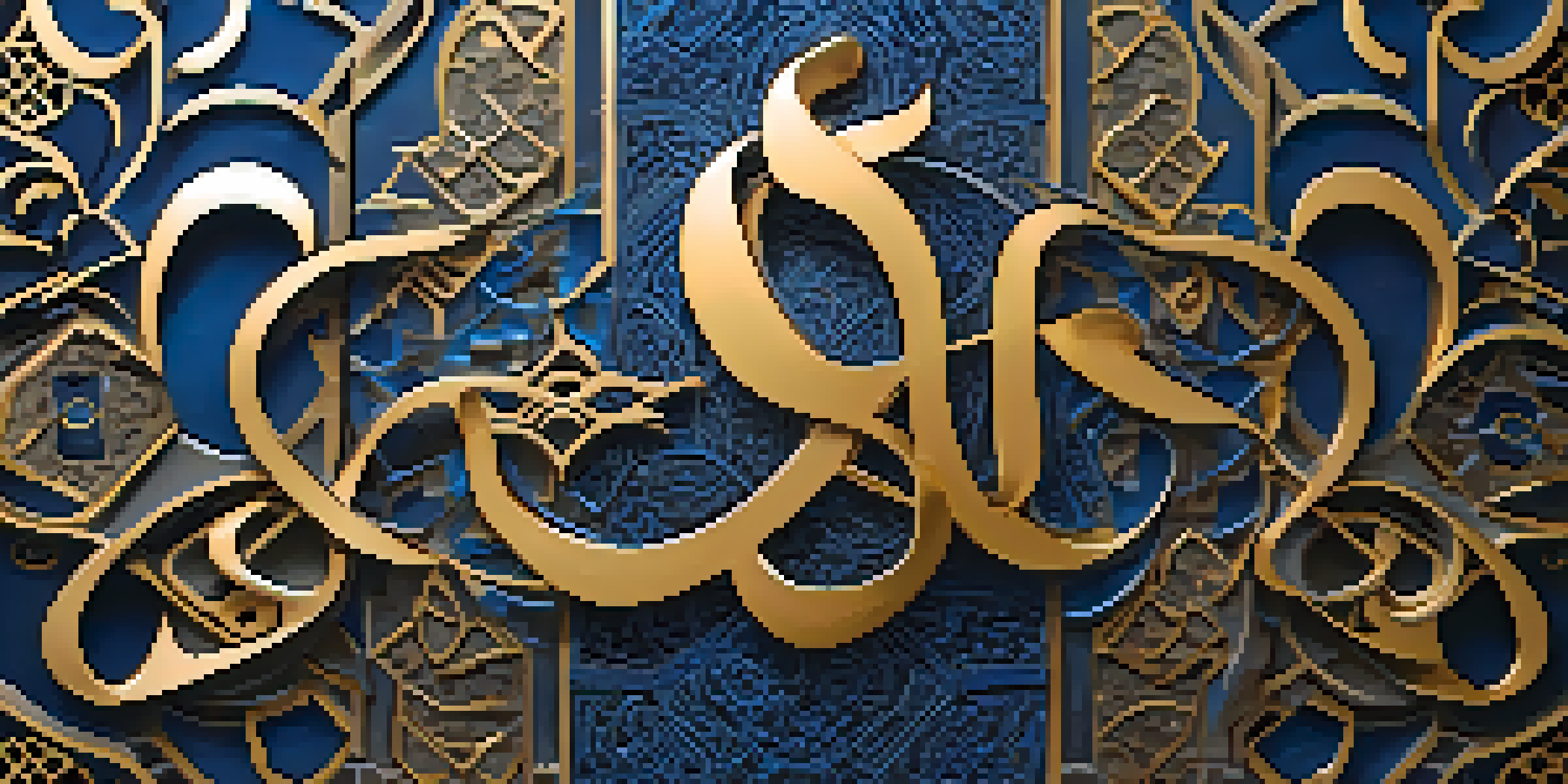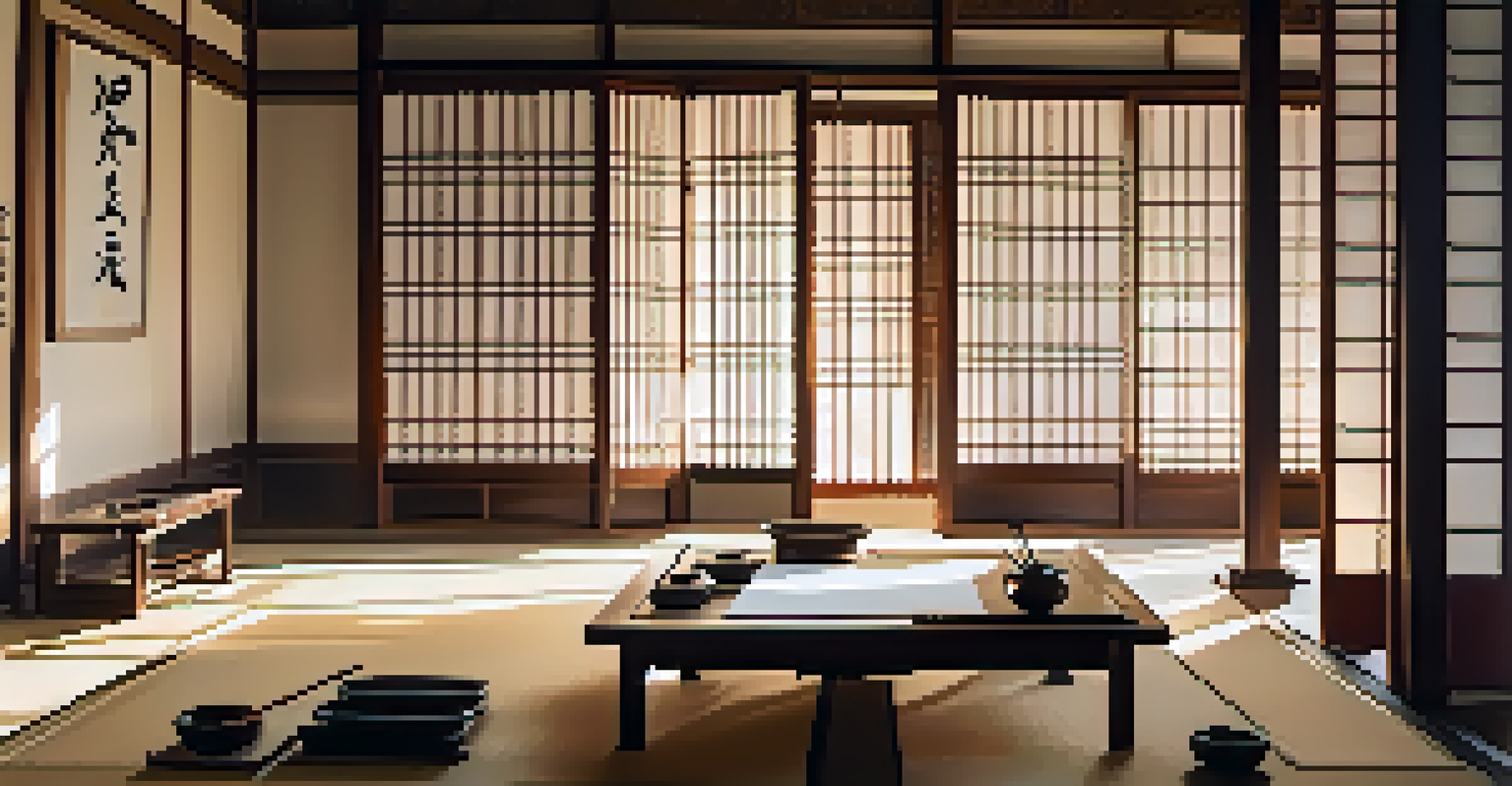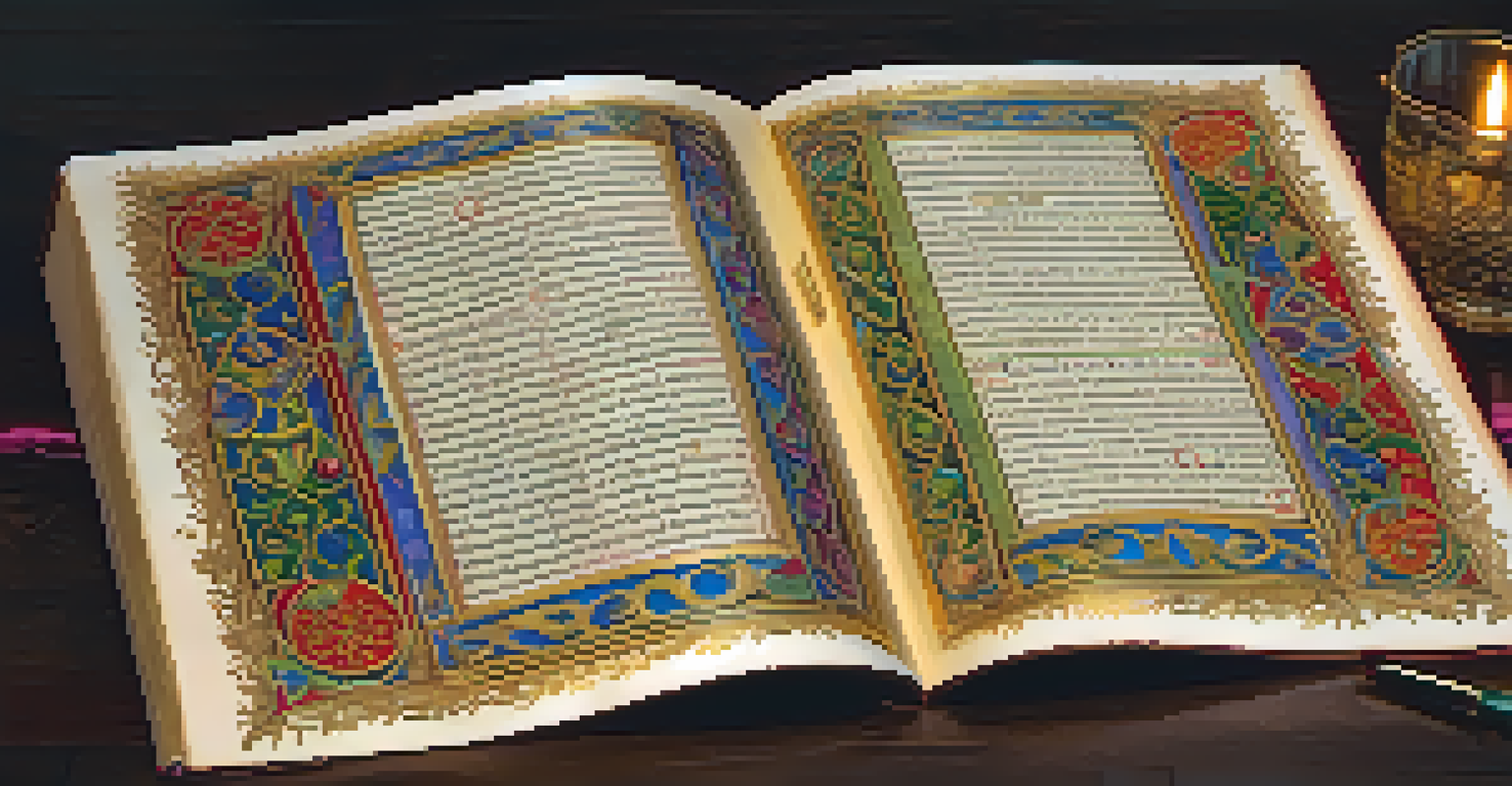Calligraphy in Religious Texts: A Historical Overview

The Origins of Calligraphy in Religious Contexts
Calligraphy, the art of beautiful handwriting, has deep roots in various religious traditions. It emerged as a way to beautify sacred texts, making them more than mere words on a page. The earliest examples can be traced back to ancient civilizations, where scripts were often designed to reflect the divine nature of the messages they conveyed.
Calligraphy is a kind of music that you can see instead of hear.
In many cultures, religious texts were not just functional; they were viewed as sacred artifacts. For instance, in ancient Egypt, hieroglyphics adorned temple walls, conveying spiritual significance and reverence. Similarly, in early Christian manuscripts, calligraphic styles were developed to enhance the reading experience and underscore the importance of the scriptures.
As societies evolved, so did calligraphy. It became a means of expressing devotion, with each stroke considered a form of prayer. This intertwining of art and spirituality laid the foundation for calligraphy’s enduring role in religious traditions across the globe.
Islamic Calligraphy: A Unique Artistic Expression
Islamic calligraphy stands out for its intricate designs and deep spiritual significance. Unlike other religious art forms, Islamic tradition often prohibits depicting human figures, which led to the flourishing of calligraphy as a primary means of artistic expression. The beauty of Arabic script became a reflection of divine beauty itself, with words forming elaborate patterns.

Prominent styles, such as Thuluth and Naskh, were developed to enhance the reading of the Quran. These styles not only beautified the text but also facilitated its recitation, making the words of God accessible to all. Calligraphers were seen as artists and spiritual leaders, intertwining their craft with their faith.
Calligraphy's Spiritual Roots
Calligraphy has evolved from a means of beautifying sacred texts to a profound expression of faith across various religious traditions.
Today, Islamic calligraphy continues to evolve, blending traditional techniques with modern artistic expressions. It serves as a bridge between the past and present, reminding us of the enduring power of language as a means of connecting with the divine.
The Role of Calligraphy in Christian Manuscripts
In the Christian tradition, calligraphy played a pivotal role during the Middle Ages, especially in the creation of illuminated manuscripts. Monks painstakingly copied scriptures, often embellishing them with ornate letters and illustrations to convey the sacredness of the text. This practice not only preserved religious teachings but also transformed them into works of art.
Writing is a form of prayer, a way to express devotion through the beauty of the written word.
One of the most famous examples is the Book of Kells, a stunning manuscript that showcases the beauty of Celtic calligraphy. The intricate designs and vibrant colors reflect both artistic skill and deep spirituality, inviting viewers to contemplate the divine. Such manuscripts became treasures, often displayed in churches and monasteries.
As the printing press emerged, the role of calligraphy evolved, but its influence remained significant. Calligraphers adapted their skills to create beautiful printed texts, ensuring that the beauty of scripture continued to resonate with readers across generations.
East Asian Calligraphy: A Spiritual Practice
East Asian calligraphy, particularly in China and Japan, embodies a unique blend of art and philosophy. The practice is rooted in the belief that the act of writing is a form of meditation, allowing calligraphers to express their inner thoughts and emotions. This spiritual connection elevates the written word to a sacred level.
In Chinese culture, calligraphy is often considered one of the highest forms of visual art. The characters are not just letters; they are a representation of the writer's spirit and character. Each stroke is intentional, reflecting the calligrapher's state of mind and emotional depth, making every piece a personal expression of devotion.
Cultural Identity Through Calligraphy
In many cultures, calligraphy symbolizes not only religious beliefs but also cultural heritage, reinforcing community ties.
Japanese calligraphy, or Shodo, similarly emphasizes the meditative aspect of writing. Practitioners believe that through calligraphy, one can achieve harmony and balance. This form of expression continues to thrive, highlighting the enduring connection between faith, art, and personal reflection in East Asian cultures.
The Influence of Calligraphy on Cultural Identity
Calligraphy often serves as a crucial aspect of cultural identity, particularly in religious contexts. For many communities, the scripts used in sacred texts symbolize not only their faith but also their heritage and history. This connection between language and identity is particularly evident in regions where a specific script is tied to religious practices.
For example, in the Jewish tradition, Hebrew calligraphy is not just about the written word; it's a vital part of cultural expression and continuity. The beautifully crafted Torah scrolls are a testament to the importance of preserving both faith and culture through art. Each letter is imbued with spiritual meaning, reinforcing the bond between the community and its traditions.
Similarly, the revival of traditional scripts in various cultures highlights the ongoing importance of calligraphy in maintaining cultural identity. As people seek to reconnect with their roots, the art of calligraphy becomes a powerful tool for expressing faith and heritage in a rapidly changing world.
Modern Adaptations of Calligraphy in Religious Texts
In the contemporary world, calligraphy has adapted to new technologies and artistic trends, yet its spiritual essence remains intact. Many artists are now exploring digital calligraphy, merging traditional techniques with modern tools to create unique interpretations of religious texts. This evolution allows for broader accessibility and engagement with sacred writings.
Social media platforms have also played a significant role in revitalizing interest in calligraphy. Artists share their works online, reaching an audience that appreciates the blend of art and spirituality. This modern approach invites a new generation to explore the beauty of religious texts through the lens of calligraphy.
Modern Innovations in Calligraphy
Contemporary calligraphy merges traditional techniques with modern technology, making sacred texts more accessible and engaging.
Despite these changes, the core principles of calligraphy—patience, precision, and devotion—continue to resonate with practitioners. Whether through traditional methods or innovative techniques, calligraphy remains a powerful means of connecting with the divine and expressing faith in a visually compelling way.
The Future of Calligraphy in Religious Practices
As we look to the future, the role of calligraphy in religious practices is likely to evolve further, influenced by cultural shifts and technological advancements. New generations of calligraphers are emerging, eager to explore the intersections of faith, art, and modernity. This evolution presents both challenges and opportunities for the preservation of this ancient art form.
Educational initiatives and workshops are becoming more common, aiming to pass down traditional calligraphy techniques while encouraging innovation. By fostering a deep appreciation for the art, these programs ensure that the spiritual significance of calligraphy is not lost. This commitment to education is essential for keeping the art alive in contemporary contexts.

Ultimately, the future of calligraphy in religious texts holds great potential. As artists continue to experiment and adapt, they will undoubtedly find new ways to express the timeless beauty and significance of sacred writings, ensuring that calligraphy remains a vibrant part of religious life for generations to come.